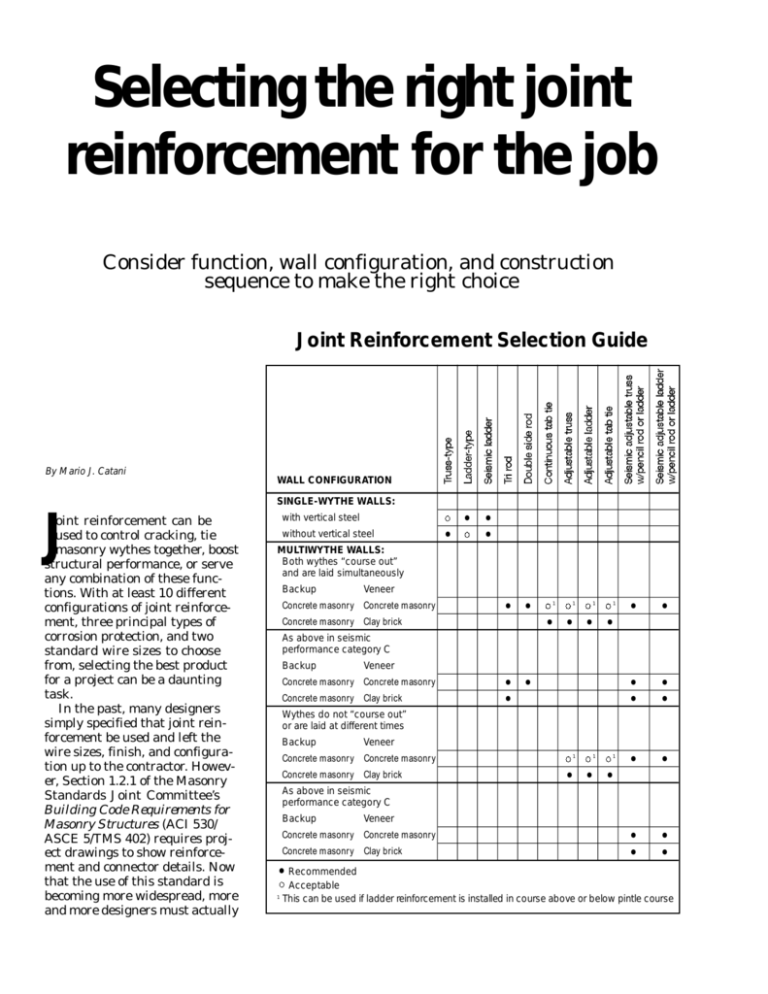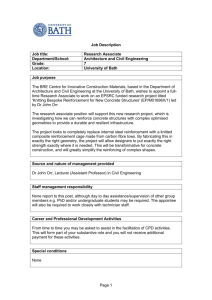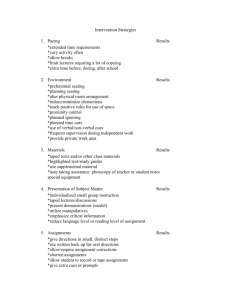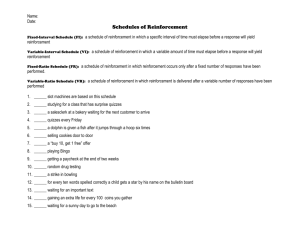
Selecting the right joint
reinforcement for the job
Consider function, wall configuration, and construction
sequence to make the right choice
Joint Reinforcement Selection Guide
By Mario J. Catani
WALL CONFIGURATION
SINGLE-WYTHE WALLS:
J
oint reinforcement can be
used to control cracking, tie
masonry wythes together, boost
structural performance, or serve
any combination of these functions. With at least 10 different
configurations of joint reinforcement, three principal types of
corrosion protection, and two
standard wire sizes to choose
from, selecting the best product
for a project can be a daunting
task.
In the past, many designers
simply specified that joint reinforcement be used and left the
wire sizes, finish, and configuration up to the contractor. However, Section 1.2.1 of the Masonry
Standards Joint Committee’s
Building Code Requirements for
Masonry Structures (ACI 530/
ASCE 5/TMS 402) requires project drawings to show reinforcement and connector details. Now
that the use of this standard is
becoming more widespread, more
and more designers must actually
with vertical steel
without vertical steel
• • •
• • •
MULTIWYTHE WALLS:
Both wythes “course out”
and are laid simultaneously
Backup
Veneer
Concrete masonry Concrete masonry
Concrete masonry Clay brick
• • • • • • •
• • • •
•
• •
•
•
•
•
•
• • • •
• • •
•
•
•
•
•
1
1
1
1
As above in seismic
performance category C
Backup
Veneer
Concrete masonry Concrete masonry
Concrete masonry Clay brick
Wythes do not “course out”
or are laid at different times
Backup
Veneer
Concrete masonry Concrete masonry
Concrete masonry Clay brick
1
1
1
As above in seismic
performance category C
Backup
Veneer
Concrete masonry Concrete masonry
Concrete masonry Clay brick
• Recommended
• Acceptable
1
This can be used if ladder reinforcement is installed in course above or below pintle course
Figure 1. Joint reinforcement for single-wythe walls
select a specific type of joint reinforcement. The following guidelines can help in making the appropriate choice.
Single-wythe walls
For single-wythe walls there are three configurations of joint reinforcement: truss, ladder, and seismic ladder (Figure 1). Truss-type reinforcement is
the best configuration for all single-wythe walls except those that are vertically reinforced. The diagonal cross wires contribute to the reinforcement’s
tensile capacity to resist shrinkage stresses, tension due to bending in the horizontal plane, and inplane shear. Truss-type reinforcement also provides
about 35% more steel area than ladder-type.
In vertically reinforced single-wythe walls, ladder-type joint reinforcement is preferred. Though
not as strong as the truss-type, it interferes less
with the placement of vertical steel.
Seismic ladder is a special type with two connected wires for each face shell but no wires that span
the width of the masonry units. It is designed for
use where vertical bars are installed first, and the
concrete masonry units are laid around the bars.
Seismic ladder-type eliminates the need to thread
joint reinforcement over the vertical steel. It also
provides twice the steel area of the regular laddertype, which helps in meeting the minimum steel requirements for reinforced masonry in high seismic
areas.
A. Ladder
B. Truss
Multiwythe walls
Since the 1950s, most multiwythe walls have
been made up of a concrete block backup with a
clay brick veneer or outer wythe. In this application, the joint reinforcement is used both to reinforce the block backup against shrinkage and to act
as a wall tie connecting the outside brick wythe.
No shrinkage steel is needed in clay brick masonry. However, when architectural concrete masonry
units are used in the outer wythe, joint reinforcement is needed for shrinkage control in both
wythes. The cross wires still serve as wall ties.
C. Seismic ladder
Figure 2. Adjustable tie joint reinforcement
A. Truss-type adjustable tab tie
B. Truss-type eye and pintle tie
Figure 3. Reinforcement for multiwythe concrete masonry walls
A. Ladder-type trirod
B. Ladder-type double side rod
Adjustable assemblies
C. Ladder-type seismic tab tie
Adjustable assemblies (Figure 2), truss- or ladder-type backups with eye and pintle or tab connectors, are the best choice for multiwythe walls. Regardless of the materials used in the wall, the
sequence of construction, or the seismicity of the
area, adjustable assemblies offer significant benefits. Because they require additional manufacturing
steps, adjustable assemblies cost more than other
joint reinforcement. But many contractors find the
cost difference is balanced by increased productivity on the job.
Adjustable assemblies resist lateral movements,
but allow up to 11⁄4 inches of vertical movement between wythes. Therefore they can accommodate the
differential vertical movements that occur between
wythes of clay and concrete masonry units. They al-
Figure 4. Continuous tab tie reinforcement for multiwythe brick
and concrete masonry walls
to 11⁄4 inches.
This misalignment can be up
or down since
pintles can be installed either
way.
Trirod and
double side rod
so allow for differential thermal
movements of concrete masonry
veneers and insulated concrete
masonry backup wythes.
Besides thermal and moisture
movement, adjustable assemblies
accommodate slight coursing variations between wythes, which is
especially important when the
backup and veneer wythes are
built sequentially rather than simultaneously. The vertical sections of adjustable wall ties also
can be used to hold rigid insulation in place in a wall cavity.
In some cases, adjustable assemblies alone are insufficient.
When concrete masonry veneers
are used, the outer wythe needs
additional joint reinforcement to
control shrinkage cracks. This
“extra” steel can be laid in the
mortar joint next to the pintle
or installed in the bed joint one
course above or below the pintle
course.
In areas of high seismic activity, a single wire reinforcement is
required in both clay and concrete masonry veneers. The sheet
metal tab tie shown in Figure 2C
is designed for seismic areas and
contains a clip to hold the additional wire.
When adjustable ties are used,
they must meet specific requirements to satisfy the code. One
code provision to keep in mind
limitstheverticalmisalignment of
the bed joints in adjacent wythes
Trirod and
double side rod
joint reinforcement (Figure 3),
available in a
truss or ladder
configuration, is
appropriate for
multiwythe concrete masonry walls. One longitudinal wire should be provided for
each mortar bed joint. For a hollow block backup with a solid
concrete masonry veneer, use
trirod.
Trirod also works well for brick
veneer/block backup walls erected in high seismic areas, where a
single continuous wire is needed
in the veneer for ductility and
better anchorage.
Trirod and double side rod
should not be used when the
wythes are laid at different times
or when wide insulation boards
are used. And the truss configuration should never be used when
insulation is installed between
the wythes—the additional steel
can restrain normal differential
in-plane thermal movements between the wythes and lead to
cracking.
Continuous tab ties
Continuous tab tie reinforcement (Figure 4) combines truss
or ladder type reinforcement for
the concrete masonry backup
with factory-welded rectangular
ties to connect the clay masonry
veneer. Lower in cost than adjustable assemblies, it can be
used in uninsulated cavity and
composite walls where the inner
and outer wythes are laid simultaneously. If insulation is used, it
should be only 16 inches wide so
it does not interfere with the pro-
jecting tabs.
Continuous tab ties should not
b eu s e dw h e nb o t hw y t h e sa r ec o ncrete masonry; these ties lack a
continuous wire to control shrinkage cracking in the outer wythe.
Wire size
Joint reinforcement can be
made in many sizes but the two
most common are standard 9
gauge (W1.7) and extra-heavy 3⁄16inch (W2.8). When deciding on
the size, consider three factors:
the area of steel needed to resist
stress; the bond strength of the
mortar; and the mortar joint
thickness.
For crack control, joint reinforcement made with 9 gauge
wire and spaced at 16 inches on
center vertically generally is adequate. For joint reinforcement required to resist bending in reinforced masonry, calculate the
steel area using standard design
procedures. Whenever possible,
specify standard reinforcement
spaced at 8 inches or less rather
than extra-heavy reinforcement
spaced at 16 inches.
Tests show that Type N mortar
is not strong enough to fully develop the strength of 3⁄16-inch-diameter joint reinforcement. In
other words, a wall built with
Type N mortar with 3⁄16-inch joint
reinforcement at 8 inches on center is no stronger than one with
3
⁄16-inch joint reinforcement at 16
inches on center. Therefore, using 3⁄16-inch joint reinforcement
makes sense only when Type M
or S mortar is used.
One compelling reason to use 9
gauge reinforcement is for fit and
constructability. While the code
allows joint reinforcement to have
a diameter one half the mortar
joint width, the tolerances allowed for units, joints, and the
wire itself can hinder the placement of large diameter reinforcement. Use it only when there is
no other choice.
Finish
The issue of corrosion protection for joint reinforcement and
wall ties has been clarified in recent editions of the code. There
are two ways to provide corrosion
protection—bygalvanizing carbon
steel or by using ASTM A 167
Type 304 stainless steel (Ref. 1).
Galvanized reinforcement must
be hot-dipped galvanized after
fabrication, according to ASTM A
153 (Ref. 2). This process is required for any material in an outside wall or an inside wall subject
to a relative humidity over 75%.
Other inside walls need only be
made of galvanized wire conforming to ASTM A 641 (Ref. 3) with
0.1 ounce of zinc per square foot
of surface area.
Conclusion
Choosing the correct configuration, size, and finish for joint reinforcement is not a difficult task.
To do it right, simply consider the
function of the reinforcement, the
configuration of the wall, and the
products available. The table on
page 8 can serve as a general
guide. The proper joint reinforcement can simplify masonry detailing, facilitate construction,
and reduce costs.
Mario J. Catani is president of Dur-OWal Inc., Arlington Heights, Ill., a manufacturer of ties, anchors, and joint
reinforcement.
References
1. ASTM A 167, “Specification for Stainless
and Heat-Resisting Chromium-Nickel Steel
Plate, Sheet, and Strip,” American Society
for Testing and Materials, 1916 Race St.,
Philadelphia, PA 19103.
2. ASTM A 153, “Specification for Zinc
Coating (Hot-Dip) on Iron and Steel Hardware,” ASTM.
3. ASTM A 641, “Specification for ZincCoated (Galvanized) Carbon Steel Wire,”
ASTM.
Other useful information on joint reinforcement
NCMA-TEK 12-2, “The Structural Role of
Joint Reinforcement in Concrete Masonry,”
National Concrete Masonry Association,
2302 Horse Pen Rd., Herndon, VA 22071
Technical Bulletin No. 93-1, “How Does 3⁄16"
Diameter Fit In?” Dur-O-Wal Inc., 3115 N.
Wilke Rd., Arlington Heights, IL 60004
Technical Bulletin No. 92-1, “Joint Reinforcement/Connector Detailing Guide,”
Dur-O-Wal Inc.
PUBLICATION # M950008
Copyright © 1995, The Aberdeen Group
All rights Reserved









